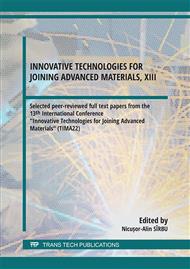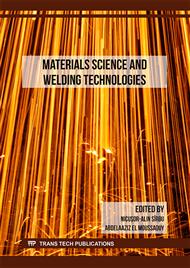p.105
p.111
p.119
p.125
p.133
p.139
p.153
p.163
p.171
Application of Static Magnetic Field to Modify Heat and Mass Transfer during Welding of Shipbuilding Steel
Abstract:
Welding process is very important in numerous industries ranging from automotive and aviation to shipbuilding and pressure vessel production. Nowadays new methods to improve the productivity and quality of various welding techniques are searched. In many industrial applications even small process optimizations may lead to significant cost and energy savings and new applications. Large plate welding is particularly important in shipbuilding industry. It is common to weld multiple times to join thick plates, but this approach is not optimal from energy and time effectiveness and outcome quality is limited. Alternative is single high heat input welding, which causes various problems related to rapid local overheating and the formation of inhomogeneous post-weld microstructure. There are several heat affected zones near the weld pool, which has different properties and microstructure due to different cooling rates and heat flux orientation during solidification. Since welding is a complex multiphysical process there are various parameters such as electric current, oxygen presence, heat flow and weld pool flow which influence the quality of welding joint and efficiency of the process. In this paper we aim to experimentally and theoretically investigate how to modify heat and mass transfer in the weld pool and heat affected zone by static magnetic fields. Electromagnetic force is one of the ways how to affect the weld pool flow and to influence the heat and mass transfer from the weld pool to the base metal. Our research demonstrates that moderate DC magnetic field can cause various effects on the post-weld morphology, depending on the magnetic field direction. Analytical estimates and similarity analysis for high heat input welding on EH36 shipbuilding steel shows that electromagnetic methods, like application of DC magnetic field can be promising approach for improved welding outcome in some cases.
Info:
Periodical:
Pages:
133-138
Citation:
Online since:
August 2023
Authors:
Keywords:
Price:
Сopyright:
© 2023 Trans Tech Publications Ltd. All Rights Reserved
Share:
Citation:



